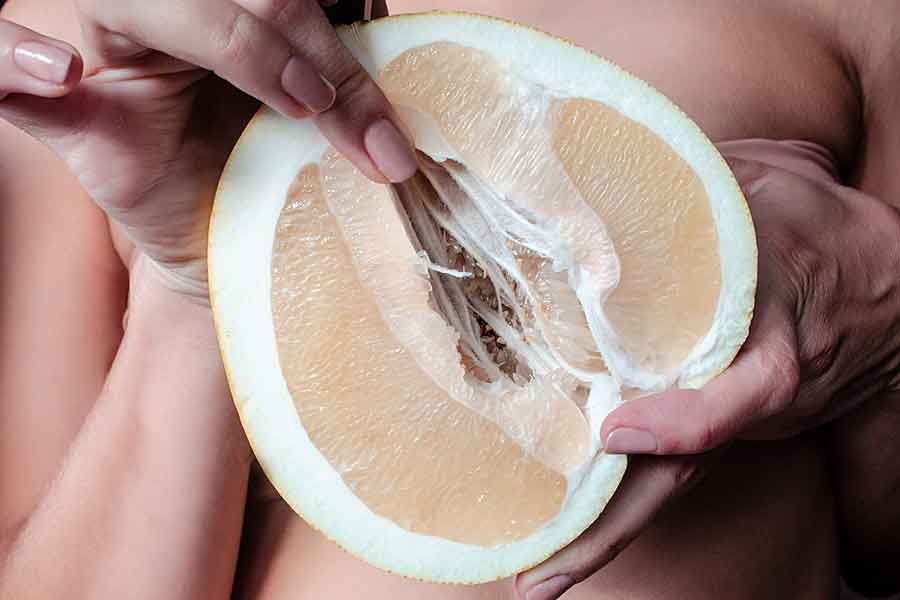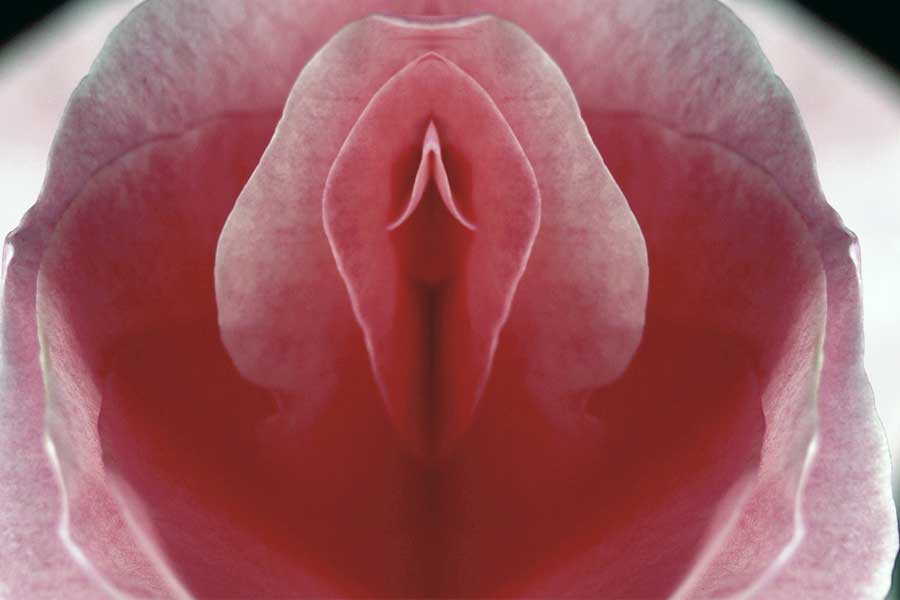Trusted for 24+ Years
Clitoral & Vaginal Orgasm Guide

Dr. Lisa Lawless, CEO of Holistic Wisdom
Clinical Psychotherapist: Relationship & Sexual Health Expert
 Female Orgasm History
Female Orgasm History
Women's orgasms have been an elusive part of history because of the lack of study of women's sexuality. Even now, there are 16 to 21 percent of women who have never had an orgasm, and 8 to 20 percent of women who find vaginal sex painful.
In the past sexual education for women focused on reproduction and the menstrual cycle. Please and how to achieve orgasm was often not taught, and when it was, there was and still is a great deal of misinformation. In the early 1900s, Austrian neurologist Sigmund Freud (the father of psychoanalysis) erroneously theorized that there were two types of female orgasms: clitoral and vaginal. He wrongly thought that it was a sign of psychosexual immaturity and sometimes mental illness if a woman could not orgasm vaginally.
Antiquated Sociosexual Scripts
A sociosexual script is our expectations of what sex is supposed to be. Our education, upbringing, media influences, religious beliefs, and more influence these expectations. There is often a depiction of the importance of sexual pleasure focused on heterosexual males with the expectation that all the pleasure a female will receive is from his penis through vaginal intercourse. Yet, through studies and research, we know that this stereotype significantly lacks an understanding of sexual diversity and that women's sexual pleasure is much more complex.
Another issue is that women tend not to communicate about what they want sexually as it is often not part of the sociosexual script. Another challenge is that women tend not to masturbate as much as men to learn what they enjoy and thus are not familiar with what to communicate in the first place.
Making A Woman Orgasm
Today, when you read about female orgasms, most articles have catchy titles such as "How To Make A Woman Orgasm." Let us be clear. You cannot make anyone orgasm; you merely create the context in which someone may have one. Orgasms are like laughter; no one makes you laugh; rather, we laugh when the conditions are right. This also applies to orgasms. So, the question then becomes, what are the most effective conditions for women to have an orgasm?
Are There Different Types Of Orgasms?
When people refer to a vaginal orgasms, clitoral orgasms, cervical orgasms, nipple orgasms, etc. they are referring to the part of the body that was stimulated to reach an orgasm. However, the orgasm is always physically originating in the clitoris versus in the vagina, anus, or other erogenous zones. Furthermore, 70-80% of women require direct clitoral stimulation in order to orgasm.
Realistic Expectations About Female Orgasms
There are so many hype laden articles promising orgasms to women. Even in the sex toy industry (ourselves excluded) there are one sex toy description after another with guarantees and promises of orgasms. The bottom line, nothing is a sure thing. Anyone who says that is trying to sell you something, so look at what their motivation is through such claims. Is it hype to sell a show, a magazine, market their website, or sell you a product?
Orgasms depend on various factors such as age, health, environment, sexual preferences, stress levels, time factors, the quality of your relationship with your partner and yourself, and more. Someone telling you that a sexual technique or sex toy will be perfect for every woman at every time is lying to you. There are just too many variables to make such baseless claims.
Studies show that ten to fifteen percent of all women who live in the United States have never had an orgasm. Seventy-five percent of women will never have an orgasm from sexual intercourse alone without the extra help of sex toys, hands, or tongue (cunnilingus). This often leads many women and couples to feel that they are somehow inadequate or dysfunctional when it comes to having a satisfying sex life.
Vaginal Orgasms & Intercourse
Most women do not have orgasms through only penis or non-vibrating dildo penetration alone. Only around twenty percent of women will have a vaginal orgasms through penetration in their lifetime. Those women have more nerve endings in their clitoris connected to their vagina wall, so there is a physical reason for this, and it is not an issue of mind over matter or sexual techniques.
The media is often misrepresenting women's orgasms through television shows, movies, and pornography by presenting heterosexual sexual intercourse as the ideal means of achieving an orgasm. Lack of vaginal orgasms from penetration is because the clitoris is where the focus should be, and most sexual positions do not offer a great deal of clitoral stimulation. That is why using fingers and sex toys, along with strategic sexual positions that provide clitoral stimulation are more effective at creating the right conditions for a female orgasm.
The clitoris head (glans) is essentially similar to that of the head of a man's penis (frenulum). It has all the sensitive nerves in it that the head of a penis has, but they are packed into an organ that is only one-tenth of the size. Thus, imagine a man only being allowed to have the bottom part of his penis stimulated, and then you may begin to better understand why the clitoris is so important.
Because the nerve endings are packed in so tightly, the clitoris can be sensitive, meaning that softer stimulation of it initially may be the best way to stimulate it. Communication is vital so ask a woman if the pressure is what she enjoys and if she prefers direct clitoral contact with the hood pulled back or if she likes it over the hood or even to the side. We recommend women spend time masturbating, determining what they prefer first without the distraction of a lover so that she can better communicate her preferences.

Body Movement Increases Orgasm Rates
In a 2019 study done by the Journal of Sex Research, it was determined that women who moved their bodies back and forth more during sex, rather than staying still, had a much more increased chance of having an orgasm than those who did not. This was true even during vaginal intercourse with the clitoris was not being directly stimulated. This means that a woman moving back and forth during sex helps her to climax.
Nothing Is As Efficient As A Stimulator
While other stimulation such as fingers and tongue feel good to the clitoris and can bring on an orgasm, the vibrator is the most efficient at making that happen. Nearly 80% of females over the age of eighteen in the United States have a vibrator, making it the most popular type of sex toy. Married women are even more likely to use a vibrator (50 percent) than single women (29 percent).
Because it is one of the most efficient means to stimulate the clitoris, some women who use clitoral vibrators can orgasm in less than 60 seconds, and most women can orgasm under 10 minutes using them. There are a large variety of clitoral vibrators that can be used hands-free, and during intercourse, so it is pretty easy these days to integrate them into sex play with a partner as well as for solo use.
Vibrator Desensitizing Issues & Air Pulse Stimulators
One of the issues that can occur with vibrators is after a while, you can become temporarily desensitized to them (numb). This is why air pulse stimulators (clitoral suction vibrators) have become so popular as they do not create this effect. Air pulse stimulators may also be helpful to women with sexual dysfunction issues because they may require more extended amounts of tie to become aroused. It may take too long to use a vibrator that may end up desensitizing them before they can climax, so using an air pulse stimulator will afford them additional time. Please see our Air Pulse Sex Toys Guide to learn more about them.
Learn more about vibrators for couples through our Couples Sex Toys For Intercourse Guide.
Lubrication
Using lubricant may seem unnecessary if a woman is already very aroused and wet. However, an Indiana University study found that lubricant contributed to higher ratings of pleasurable and satisfying sex. It also helps to reduce vaginal tearing and STD contraction. Lubricant can also be quite useful and even necessary when using sex toys as many of the materials create more drag on the skin than a tongue, fingers or a penis.
Because the vagina and labia minora are made from sensitive tissue that consists of a mucus membrane, personal lubricants are directly absorbed into the bloodstream. That is why we recommend only using water-based lubricants that are paraben-free.
Parabens are known toxins that can contribute to a slew of health problems and are used as a germicide and preservative as they are cheap and effective. Commonly used parabens include methylparaben, ethylparaben, propylparaben, and butylparaben. Parabens are banned in France, Denmark, and other parts of Europe. Sadly, the FDA in the United States still allows them, and popular brands like Astroglide and KY lubricants still have them.
We feel the health risks of parabens are too high, and that is why we only carry paraben free lubricants. You can shop with us knowing we have done all the research for you and have peace of mind that you are choosing from the healthiest sexual products on the market.
A Partner May Feel Inadequate Or Left Out
Vibrators only provide intense stimulation; what they cannot provide is intimacy. They can't kiss, embrace, or love a woman. Women are not fantasizing about a vibrator when they use one; they crave a partner. Vibrators are no different than a carpenter using a power tool. They do not need them, nor will they get addicted to them, but it certainly makes it easier to orgasm faster with greater ease.
Whether you choose to use a sex toy, sex therapists recommend time kissing, cuddling, and whole-body sensual caressing before reaching between a woman's legs. A good rule of thumb is to seduce her mind, her body, and then her vagina.
If a partner is feeling jealous, nervous or frustrated by you wanting to use a vibrator during sex play, please read our helpful guide: Sex Toy Fears.
What Happens When A Female Orgasms?
During sexual arousal, a woman's vaginal area fills with blood. Muscles contract, physical tension builds, and when her orgasm is finally unleashed, the tension of the muscles, and blood all course through her body in waves of pleasure. Her pelvic floor muscles contract, and the uterus pulls in fluid in case sperm is there so that it can be sucked in and given a chance to create life.
During the arousal stage, a woman's vaginal lips (the labia minora) will swell and spread apart. Her clitoris, like the penis of a male, fills with blood and becomes erect. It becomes sensitive to touch and protrudes from beneath its protective hood. That is why having sex after a woman has an orgasm feels amazing.
Some women find that their nipples become erect; however, this is not the case with all women, and just because her nipples may not be erect does not mean that she is not sexually aroused.
During arousal, a woman's breathing and blood pressure will increase. Her face will become flushed, and vaginal juices will begin to flow, lubricating her vagina for the possibility of penetration.
There are no studies that have demonstrated how all women can neurologically build to an orgasm. However, we know that the muscles in a woman's pelvic floor (Kegel muscles) will contract. As pleasure radiates through her body, sometimes there is a desire to moan or deeply exhale. Others, however, may find a quiet peace with no sound at all. There are many reactions to orgasms, including laughing, crying, and even combinations of the two. Women do not always experience orgasms the same way and can have some that are more deeply felt physically and emotionally over others.
Variations of the pleasure and sensation of a female orgasm can depend on many factors such as mood, type of stimulation, the intensity of stimulation, hormone levels, sobriety, fatigue, and partner.
Why Do Women Sometimes Cry After An Orgasm?
Various factors can cause a woman to cry after an orgasm: the release of stress, depression, or sexual tension, as well as feelings of vulnerability, physical discomfort, and hormonal changes. Having an orgasm temporarily causes dopamine levels, promoting feelings of pleasure and satisfaction, and oxytocin, which promotes feelings of trust, empathy, and connection to spike. These hormones can also release emotions you may have been holding in within your life in general, which may evoke laughter or tears.
Faking An Orgasm
The truth is that most women are so good at faking orgasms you may never really know. Many males think that they would be able to tell, but even the most attentive lovers can be fooled. Women can moan, squeeze their Kegel muscles to mimic an orgasm, and even bear down and push.
Sixty-six percent of the women who fake orgasms say that they moan to speed up their partner's orgasm, while eighty-seven percent moan to fake an orgasm and end sex. Women report that they may fake moaning if they get tired, bored, or uncomfortable during sex to end it and avoid hurting their partner's feelings.
See more about this in our article: Why Women Fake Orgasms.
What Woman Can Do To Achieve An Orgasm
Explore
First and foremost, learn about your own body through sexual exploration on your own. Masturbation is not just physically healthy; it helps you to understand what your body responds to sexually. In turn, it will act as a sexual map allowing you to guide your partner(s) when you have sexual interactions with them.
Try different sex toys from nipple toys, clitoral and G-spot vibrators, rabbit vibrators, air pulse sex toys, estim, and dildos to determine if you prefer one type of stimulation over another. Also, try stimulating lubricants in addition to water-based lubricants to determine if you enjoy those sensations.
See our Female Masturbation Guide for more information.
Communicate
Studies show that 86% of lesbians have orgasms with their female partners, whereas only 65% of heterosexual women have orgasms with their male partners. The critical difference is that lesbians tend to communicate better and take turns pleasuring one another.
The importance of communication is also reflected in cases where only 11% of heterosexual women have orgasms with a male partner after their first time having sex, whereas 33% of heterosexual women have orgasms with a male partner after the fourth time they have sex as there tends to be better communication.
Express what will help bring you to orgasm during sex play. Sexual techniques are just a part of what you will need to communicate. Also, discuss what you enjoy regarding music, location, sensations, verbal cues, sounds, light levels, lubrication, BDSM role play, sex toys, porn, and sex positions. Discuss if you prefer to be more dominant, submissive or wherever the sexual play takes you.
Communication can also happen without words through your sexual sounds (moans, sighs, and screams) or physically by taking your partner's hands or parts of their body and showing them.
There are various ways women can achieve orgasm, and it comes down to mental state, arousal level, and physical stimulation of erogenous zones.

The most obvious of the erogenous zones are the vaginal region, which includes: clitoris, labia, G-spot, A-spot (side of cervix), Mons (pubic mound), and cervix.
Below are the major erogenous zones along with others that are also rich in nerve endings and can provide a great deal of pleasure when stimulated.
- Areola & Nipples
- Mouth & Lips
- Inner Thighs
- Nape Of The Neck
- Inner Wrist
- Buttocks
- Scalp (Playing With Hair)
- Behind Of The Knee
- Earlobe
- Feet
- Navel & Lower Stomach
- Small Of The Back (Sacrum)
- Inner Arms & Armpits
- Palm Of Hands & Fingertips
Stimulating The Clitoris
The clitoris is extraordinarily rich in nerve endings (15,000), which is why it has a hood that goes over it. It protects the sensitive tissue from excessive stimulation during movement. Some women have larger hoods than others, which may mean that it is more difficult to retract.
Clitoral Adhesions & Excess Hood Covering
Some women can develop clitoral hood adhesions where the hood gets stuck to the clitoris and cannot be moved back. According to the Journal of Sexual Medicine, one in five women who went to a sexual medicine practice have a clitoral adhesion. Adhesions can cause pain and cause difficulties with experiencing sexual pleasure and orgasm. They can be caused by not washing well, trauma, fungal or bacterial infections, genital dermatologic conditions (lichen sclerosus), or insufficient sex hormones. Washing more diligently can resolve or prevent clitoral adhesions. If you're experiencing discomfort, you can try soaking in a warm bath and cleaning the area more frequently. If you are unable to loosen the skin, then you should consult your physician.
If a woman has excessive hood tissue hanging over the clitoris or it is very thick, she can opt to have a hoodectomy, which will remove part of the clitoral hood allowing for better access to the clitoris. This should not be confused with female genital mutilation (FGM), which removes the clitoris entirely (clitoridectomy) and possibly the labia (excision) and sealing the vaginal opening (infibulation). A hoodectomy, on the other hand, can help a woman have better sexual stimulation by trimming excess tissue. It is similar to labiaplasty, which trims extra-long vaginal lips (labia minora).
Have A Clitoral Orgasm Before Penetration
Having a clitoral orgasm from direct stimulation to the head of the clitoris before having penetrative sex may make a woman more likely to have an orgasm from penetration from a penis or dildo. The reason is that the clitoris, vulva, vagina, and female prostate will all be in full arousal and engorged, making it easier for a second orgasm to occur without little to no exterior clitoral stimulation.
Clitoral Piercings
In 2005, a study of vertical clitoral hood piercings found that they do not enhance pleasure or the ability to orgasm. They are linked to increased sexual desire and frequency of arousal; however, why is it not clear. It could be because there is movement there, or it can merely be psychological awareness of one's sexuality by having a piercing there.
Intense Or Gentle Stimulation To The Clitoris?
Some women find direct clitoral stimulation to be too intense, while others prefer it. Those who do not prefer direct contact can keep the clitoral hood down and stimulate the clitoris on the sides rather than directly on top of it, whether you choose to use fingers, a vibrator, tongue, or the head of the penis.
- Use fingers to stimulate the clitoris by rubbing around and on it. See our Fingering Tips for more details.
- Use the penis to stimulate the clitoris by sliding it up and down the labia and up to the clitoris.
- Use a vibrator to stimulate the clitoris either directly on it or to the side.
- Utilize sex positions that allow a woman to grind against your pubic bone and rub her clitoris against you. For heterosexual couples, the man can penetrate the vagina while she does this. For lesbian couples you can use strap-on dildos, and double dildos for mutual penetration that may or may not have vibrators attached.
For more information on how to stimulate the clitoris, please see our Clitoral Stimulation Guide
How To Stimulate The G-Spot
The G-spot is an area that is between the size of a quarter and a silver dollar. It is located about 2.5 - 3 inches on the inside, on the top side of the vaginal wall. Sometimes it cannot be detected unless a woman is aroused as it fills with fluid and becomes more prominent. It is a source of rich, deep sexual pleasure when it is felt.
All women have a G-spot, but some have thinner tissue there, making it more difficult to feel. Those who have thicker tissue report greater pleasure when stimulated and are more easily able to have an orgasm. Think of it this way, some people have more sensitive nipples than others, and some are larger and others smaller, but they all have nipples.
The best way to find the G-spot is to first use your fingers, remembering that the G-spot responds more to pressure than just a superficial rubbing. Moving your fingers up into the G-spot can provide enhanced pleasure and intensity of sexual arousal. Using your finger in a come here motion is the most common way to stimulate the G-spot.
Is There Such A Thing A G-spot Orgasm?
While the G-spot exists and certainly feels good to be stimulated, women are having an orgasm from stimulation to the clitoral legs. The clitoris that people often refer to is just the head of the clitoris. The full clitoris is shaped like the letter "Y," much like a wishbone, and the two parts that come off are the central part is called the crus of the clitoris or clitoral legs. When a penis, dildo, or fingers are inserted into the vagina, the clitoral legs and the G-spot are both stimulated. Thus, it is difficult to know for certain what stimulation is bringing on the orgasm. For the sake of making things simple, however, we will typically refer to such an orgasm as a G-spot orgasm.
As previously mentioned in this article, an orgasm is always occurring in the clitoris. When we refer to a vaginal orgasm, clitoral orgasm, etc. we are referring to the part of the body that had to be stimulated for a woman to reach the orgasm.

For more information on how to stimulate the G-spot during sex, while using a dildo or with fingers, please see our G-Spot Guide.
Do Kegel Exercises Help Achieve Orgasms?
Kegel exercises push more blood into a woman's vaginal walls, so she's biologically more aroused, which may increase the intensity of orgasm. Also, stronger pelvic muscles make the contractions more substantial, which may impact the intensity of feeling during an orgasm. There is some mixed research on this, but overall it may help increase pleasure, and it will definitely help with overall vaginal health and functioning.
For more information, please see our guide on How To Do Kegel Exercises
Prioritizing Her Orgasm & Focusing On Pleasure
The biggest obstacles to having an orgasm are going to be stress, lack of movement and clitoral contact. If you emphasize having an orgasm as the only goal and begin to stress over it, it can be challenging to relax and enjoy the ride. Women who make it a goal to have an orgasm have higher success rates, so it is an excellent goal to have. However, focusing on the sensations of pleasure rather than the orgasm itself is the best way to attain that goal.
Think of it this way. If you ever decided to take a trip to a day spa for some relaxing massage services, the focus would not be as a task to achieve; rather, it would focus on the relaxation and pleasure of the experience.
The bottom line, there is no single best way to reach orgasm. Just keep in mind that women who prioritize their sexual pleasure by making it a goal during sex through direct clitoral stimulation and body movements that feel good to her will have a much higher success rate than those who do not.



 Female Orgasm History
Female Orgasm History

